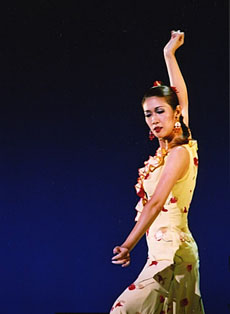Home Page » Post
« Next Article: Frida Kahlo & Diego Rivera on Mexican 500 peso bank notes
» Previous Article: Ice Cream Experiments in Valencia
Monday, August 30, 2010 (read 3438 times)
Flamenco Continues to Take Japan by Storm
by Olivia ElsonWith the economic crisis still hitting Spain hard, and unemployment figures continuing to linger around 20%, I was surprised to read that one of the most popular money-making methods for Spaniards today is to tap into the flamenco market …in Japan!
Having researched what I initially thought was an unlikely connection a little more, I've discovered that Japan has long been on the map as a flamenco hotspot, and today the Japanese Association of Flamenco estimates that there are more than 600 schools with over 60,000 students. Indeed, apparently it is common to find restaurants with dancers and guitarists in amongst the skyscrapers on the streets of Tokyo.
With flamenco becoming increasingly popular in Japan and with Japanese visitors to Spain, it's no wonder that more and more people are exploiting this and becoming teachers in one or all of the flamenco arts " singing, dancing and guitar playing.
But what I don't understand is, why Japan? It is 15,000 kilometres away from flamenco's home turf of Andalusia after all.
A little more research and I try to shed some light on exactly how this phenomenon occurred, though it's hard when among the most popular reasons given is "it's a mystery ". Saying this, some theorists have pointed out a number of similarities between the rhythms and sounds of flamenco and traditional Japanese music, including the fact that the minor key of flamenco melodies is also characteristic of Oriental songs. Also, the Spanish and Japanese languages have similar syllables and sounds, which make understanding and pronouncing the lyrics easier for Japanese cantaores (singers).
Pinpointing exactly when the art made its trans-continental journey is quite difficult, but pioneers are thought to include La Argentinita in 1929, and Carlos Montoya in 1932, who are said to have inspired early Japanese flamenco personalities such as Suzuko Kawakami.
The most productive years for the growth of flamenco however were the 50s and 60s, when a much greater number of famous artists travelled to Japan to perform and inspired many more local flamenco enthusiasts, especially in the fields of guitar playing and dancing, which is arguably the Japanese's strongest discipline of the three.
Today, flamenco is rife across Japan, particularly in big cities like Tokyo, home to Spanish restaurants, travel agencies for flamenco tours, shops selling costumes and accessories and, of course, a huge number of schools dedicated to the art. The city of Tateyama is host to an annual flamenco festival too and attracts some of the best artists from Japan and Spain. What's more, Japanese guitarists and dancers like Keiko Suzuki, Pepe Shimada and Eiko Takahashi always make a big impression at renowned Spanish festivals, particularly Seville's biennial flamenco celebration.
So, enlightened, I have changed the title of this post from "Flamenco Takes Japan by Storm" and am off to explore this interesting and surprisingly long-established cultural mix some more. That the Andalusian art has had such an impact so far away from home certainly makes it all the more impressive!

Keywords: flamenco,japan
